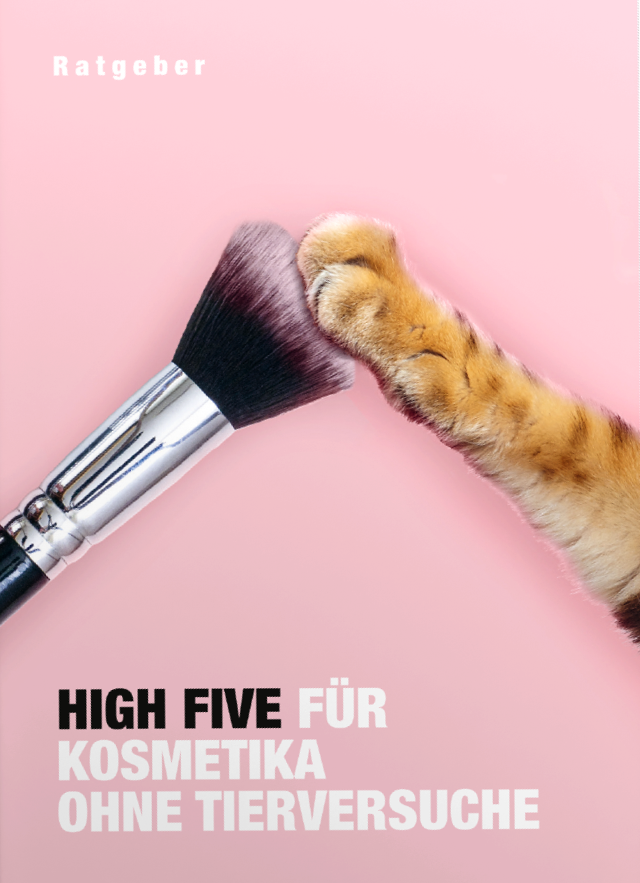Animal testing for cosmetics
In principle, animal testing for cosmetic products is prohibited in Switzerland. But the situation is different internationally: An estimated 500,000 animals are currently still being used worldwide for torturous tests for cosmetics. And in Switzerland there are loopholes in the law too – unfortunately, the ban is no guarantee for animal-test-free sales shelves.

The legal situation in Switzerland
Since 1.5.2018, according to the Swiss Ordinance on Foodstuffs and Utility Articles, there is a ban on the marketing of cosmetic products or components of these products if they have been tested on animals. However, the ordinance lists exceptions to the ban:
The ban applies only to ingredients exclusively found in cosmetics. However, 90% of all ingredients in cosmetics are also used for medicines, household cleaners or paints – and are therefore also tested on animals.
Only products and ingredients that came onto the market after the ban came into force are affected. Older goods may continue to be on the shelves, even if they have been tested on animals.
Most cosmetic products to be sold in China must be tested on animals. This is required by Chinese legislation. Products that are also sold on the Chinese market are therefore rarely free of animal testing. Nevertheless, they may still be sold in Switzerland.
Why and how are cosmetics tested on animals?
The tests are justified by the need to ensure the safety of humans and the environment from the toxic effects of marketed substances and products. Unfortunately, many circles in science, industry and politics still hold the traditional opinion that animal testing is the only way to prove the safety of substances. However, the transferability of results from animals to humans is often not possible because humans are not mice nor rats. The following are some of the animal tests carried out for safety and compatibility tests for cosmetic products and their ingredients, primarily on rodents:
Acute and chronic toxicity
Ingestion toxicity is tested in rodents by administering different doses over different time periods. Depending on the substance and dose, severe side effects such as convulsions, diarrhea, and bleeding may occur.
Skin, eye, mucous membrane irritation
Testing for skin, eye and mucous membrane irritation of substances can result in painful inflammation and chemical burns in the test animals. The Draize test, which is used to test eye irritation of substances on rabbits and is highly invasive, is particularly controversial. Unfortunately, it has not been fully replaced to date.
Skin allergies
The substance to be tested is injected into the skin of the test animals (often guinea pigs) to stimulate the immune system. The animal is then exposed to the test substance again to test for the occurrence of allergic reactions such as skin inflammation.
Toxic effect of substances under the influence of sunlight (phototoxicity)
After the test animals, usually rodents, have been injected subcutaneously with the test substance, the animals are fixed and exposed to ultraviolet radiation in the wave range 400nm-315nm (= UV-A). Depending on the test substance, massive and painful inflammatory skin irritations may occur.
The last animal experiments reported in Switzerland in the animal experiment statistics in the field of cosmetics were carried out in 2010/2011 to test phototoxicity.
Embryonic malformations (teratogenicity) and impairment of reproductive ability
Pregnant animals are administered the test substance and, in order to assess whether malformations occur in the embryo or the pregnant animal is harmed, pregnant animals are killed at different stages of pregnancy and examined.
Carcinogenicity
It is observed whether the test substance leads to the development of tumors in the animals after administration.
The Cosmetics Guide: Orientation in the Label Jungle
It is not easy to recognize animal-free cosmetics on the shelf. In the meantime, there are numerous certificates and labels available that help consumers to make the right decision. But there are still stumbling blocks: an animal-free product is not necessarily completely free of animal suffering. It may contain animal ingredients and is therefore unsuitable for a vegan lifestyle. Animalfree Research has compiled a guide (in German) that presents the most important labels and their criteria.
Order Cosmetics Guide
You will receive the guide free of charge by mail.
„*“ zeigt erforderliche Felder an
